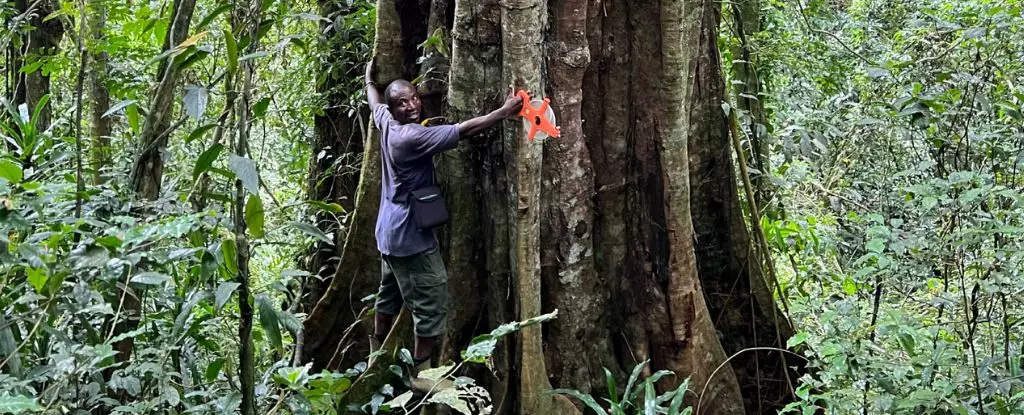In the lush embrace of Tanzania’s Udzungwa Mountains, a remarkable discovery has been made that speaks volumes about our planet’s richness and fragility. Botany enthusiasts and environmentalists alike were taken aback when Andrea Bianchi, a diligent botanist, along with local experts Aloyce and Ruben Mwakisoma, identified the majestic Tessmannia princeps—a tree that is not just another greenery but potentially a witness to 3,000 years of history. Towering at an impressive height of 40 meters and exhibiting a beauty that defies conventional categorization, this evergreen species exemplifies the wilderness that remains largely unseen and uncataloged by science.
What sets T. princeps apart is not merely its striking physical attributes—grayish light-brown bark, towering root buttresses, and sweetly fragrant flowers—but also the critical role it plays in its dwindling ecosystem. This species is not just a solitary tree; rather, it serves as an essential link between two ancient forests, offering a critical ‘ecosystem bridge’ that sustains an array of flora and fauna. Yet, this newfound marvel also stands as a testament to the devastating loss of biodiversity, making its discovery equally a cause for celebration and concern.
The Extinction Crisis Looms Large
While the discovery of T. princeps is exciting, it also paints a stark picture of the state of our natural world. With only about 1,000 individuals believed to be left, this tree is teetering on the edge of extinction. The historical context of the region reveals a troubling narrative: the montane forests surrounding the discovery site have been largely deforested over the past 120 years. Human-induced habitat destruction is not merely a statistic; it is an alarming reality that threatens the survival of countless species, including T. princeps.
Underpinning this narrative is the harsh reality of the global deforestation crisis. In 2018 alone, approximately 4 million hectares of old-growth rainforest were lost—a staggering figure that underscores the need for immediate action. As forests continue to shrink, their age dramatically decreases, leading to younger ecosystems that simply cannot offer the same range of vital services—carbon storage, biodiversity support, and climate regulation. If we are to combat climate change and preserve biodiversity, we need to embrace a new conservation ethos that prioritizes the survival of ancient species like T. princeps.
Restoration Efforts and Community Involvement
In a commendable attempt to mitigate these pressing threats, local and international stakeholders have rallied around restoration projects aimed at preserving what remains of Tanzania’s treasured rainforest. Not only do these initiatives strive to protect unique species like T. princeps, but they also aim to uplift local communities, such as the 5,500 villagers tied to the forests’ fate. The equilibrium between conservation and community welfare is crucial in these efforts. If conservation policies fail to consider local needs, the battle against extinction will face insurmountable challenges.
Thus, while the discovery of T. princeps is indeed thrilling, it simultaneously acts as a stark reminder of humanity’s urgent obligation to incorporate environmental justice in our conservation strategies. The benefits of protecting such ancient trees extend beyond their longevity; they are invaluable for climate regulation and ecosystem health. True sustainability is achieved when the rights and welfare of local populations are harmonized with the preservation of natural resources.
A Call for Urgency in Conservation
As we reflect on the significance of T. princeps, it becomes clear that this breathtaking discovery is both an invitation and a warning. We must cherish and protect these ancient organisms, as their existence stretches far beyond mere aesthetics—these trees are the lifeblood of our ecosystems. However, the pressing questions remain: Can humanity rise to the occasion? Will we fortify our commitments to environmental sustainability, or will we continue to overlook the silent cries of our planet?
In a world where scientists warn that a staggering 75% of undiscovered plant species are on the brink of extinction, T. princeps may be one of the “lucky ones” for now. But luck alone cannot sustain an ecosystem. We need a paradigm shift in how we perceive and treat nature—one of reverence, urgency, and action.


Leave a Reply